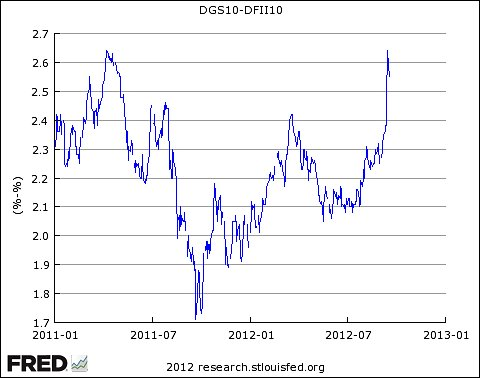U.S. Federal Reserve Chairman Ben Bernanke might not admit it, but he just drastically increased the inflation risks for 2013 and beyond.
That's because Bernanke pledged on Sept. 13 that QE3 -unlike the stimulus programs before it - will continue for an unlimited timeframe.
QE3 has already led to a rally in commodity prices, like the previous Fed stimulus actions.
But this time the inflationary surge will get much, much worse.
"If the governments and central bankers continue to flood the world with cheap money, it has to translate into some kind of inflation," Money Morning Global Investing Strategist Martin Hutchinson recently explained. "We started with asset inflation. But my sense is that the transition from asset inflation to consumer inflation will happen very quickly."
With median income levels at averages not seen since the mid-90s, U.S. households need to prepare their savings to survive higher prices - especially while interest rates remain near zero.
Unfortunately, it appears this environment is exactly what Ben Bernanke has in mind.
"Not only will they tolerate higher inflation, not only will they wish for higher inflation, but they actually may target higher inflation," PIMCO CEO Mohamed El-Erian told CNBC ofthe Fed. "This is a historical bet that our kids will be reading about in history books."
Here's what Bernanke has planned.
QE3 and Higher Inflation: The Fed's Goal
Team Bernanke thinks the threat of inflation will stimulate the economy, so higher prices are their goal.
El-Erian called it a "reverse Volcker moment," referring to former Fed Chairman Paul Volcker who raised interest rates in the early 1980s to lead to a recession that would tame inflation.
The Fed's strategy is that creating higher inflation expectations will lead to increased consumer spending in the short-term.
As in, if you expected prices to rise significantly in the future you would be more inclined to make additional purchases now rather than later.
The downside to that thinking is that if the economy is too weak and uncertainty is as prevalent as it currently is, inflation expectations will not matter. Consumers who have little to zero extra money are unlikely to suddenly spend more.
Inflation will come from increasing the monetary supply and when it does it will cripple households that are already struggling.
That's why Federal Reserve Bank of Dallas President Richard Fisher has criticized QE3.
"I do not see an overall argument for letting inflation rise to levels where we might scare the market," Fisher said Sept. 19 onBloomberg Radio's "The Hays Advantage" withKathleen Haysand Vonnie Quinn. "We have seen a sharp rise in inflation expectations. If you let this get out of hand, then I think we will have amarket reaction."
The accompanying chart from the Federal Reserve Bank of St. Louis shows us that inflation expectations, measured by the difference between the interest rate on ordinary 10-year bonds and Treasury Inflation Protected Securities with the same maturity, have skyrocketed since QE3 was announced.

Yields on conventional bonds, a 10-year Treasury bond, are calculated from two components, the real rate of interest and inflation compensation for the time period of the bond. TIPS on the other hand adjust their principal for inflation and the yield is only comprised of the real rate of interest.
As the difference between the two yields increases, inflation expectations rise.
The spread, which hit four-year highs the day after the Fed said it would implement QE3, will continue in that direction as billions of dollars are injected to the monetary supply each month and interest rates are held at record low levels.
QE3 Will Make Inflation Worse
Even though the Fed and U.S. government have denied inflation, it's already here.
Just look at data from the American Institute for Economic Research (AIER), which "backs out" the big-ticket items that are infrequently purchased by consumers. It concentrates instead on "everyday prices" - the regularly purchased items that matter most to working Americans.
Its Everyday Price Index (EPI) rose 1.8% in August compared to the U.S. Bureau of Labor Statistics Consumer Price Index (CPI) which only rose 0.6% last month. Year-to-date the EPI has increased 4.2%, three times the 1.4% increase in the seasonally-adjusted CPI.
As a consumer it will be hard to avoid higher prices, but as an investor there are ways to battle the problem.
In order to prepare for inflation investors need to look at emerging markets, real assets such as gold and silver, inflation protected securities and dividend-paying stocks.
This type of inflation and the effects of QE3 are exactly what Money Morning's Hutchinson has been preparing investors for.
In fact, Hutchinson has devised a powerful strategy to combat inflation risks. His investing plan includes a way to find stocks that provide a consistent income stream for investors.
To find out which companies he likes and learn the investing techniques that allow you to maximize your returns, click here.
Related Articles and News:
- Money Morning:
All Signs Now Point to Gold - Money Morning:
Jim Rogers On QE3, Gold, Silver and Oil - Money Morning:
When it Comes to QE3, Ben Should Have Tried the Helicopter - CNBC:
Fed Wants Inflation Now, Will Clean Up 'Mess' Later: El-Erian - Bloomberg News:
Fed's Fisher Says U.S. Inflation Expectations Rising
[epom]


